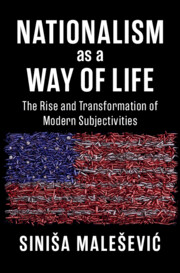Refine listing
Actions for selected content:
1295956 results in Books
2 - The Trials of Empire
-
- Book:
- The Conquest of the Mountains
- Published online:
- 14 November 2025
- Print publication:
- 11 December 2025, pp 46-69
-
- Chapter
- Export citation
Part II - Architectural Autobiographies
-
- Book:
- Rebuilding Histories in the Roman World
- Published online:
- 23 November 2025
- Print publication:
- 11 December 2025, pp 163-304
-
- Chapter
- Export citation
13 - Fin-de-Siècle Symbolism and After
-
-
- Book:
- The Cambridge History of Australian Poetry
- Published online:
- 19 November 2025
- Print publication:
- 11 December 2025, pp 240-257
-
- Chapter
- Export citation
Glossary
-
- Book:
- Fundamentals of Translation
- Published online:
- 04 December 2025
- Print publication:
- 11 December 2025, pp 321-330
-
- Chapter
- Export citation
Illustrations
-
- Book:
- The Power of Peasant Consumers
- Published online:
- 27 November 2025
- Print publication:
- 11 December 2025, pp xiv-xiv
-
- Chapter
- Export citation
Contributors
-
- Book:
- The Cambridge History of Australian Poetry
- Published online:
- 19 November 2025
- Print publication:
- 11 December 2025, pp xi-xix
-
- Chapter
- Export citation
Chapter 18 - The Underworld Painter
- from Part III - Individuals
-
-
- Book:
- Personal Religion in the Ancient Greek World
- Published online:
- 25 November 2025
- Print publication:
- 11 December 2025, pp 406-427
-
- Chapter
- Export citation
Part III - Iconic Dimensions and Magnitudes: The Conformation System of Authority Ranking
-
- Book:
- Representing Relationships
- Published online:
- 21 November 2025
- Print publication:
- 11 December 2025, pp 147-292
-
- Chapter
- Export citation

Nationalism as a Way of Life
- The Rise and Transformation of Modern Subjectivities
- Coming soon
-
- Expected online publication date:
- December 2025
- Print publication:
- 11 December 2025
-
- Book
- Export citation

Ennius Beyond Epic
- Coming soon
-
- Expected online publication date:
- December 2025
- Print publication:
- 18 December 2025
-
- Book
- Export citation
Index
-
- Book:
- The Cambridge History of Australian Poetry
- Published online:
- 19 November 2025
- Print publication:
- 11 December 2025, pp 885-920
-
- Chapter
- Export citation
Reviews
-
- Book:
- Fundamentals of Translation
- Published online:
- 04 December 2025
- Print publication:
- 11 December 2025, pp ii-ii
-
- Chapter
- Export citation
Chapter 1 - Dementia at the Bedside
- from Section 1 - Introductory Chapters on Dementia
-
-
- Book:
- The Behavioral Neurology of Dementia
- Published online:
- 17 November 2025
- Print publication:
- 11 December 2025, pp 1-8
-
- Chapter
- Export citation
Bibliography
-
- Book:
- Fundamentals of Translation
- Published online:
- 04 December 2025
- Print publication:
- 11 December 2025, pp 331-339
-
- Chapter
- Export citation
Index
-
- Book:
- The Philosophy of Antoine Arnauld
- Published online:
- 27 November 2025
- Print publication:
- 11 December 2025, pp 287-292
-
- Chapter
- Export citation
12 - Philanthropy as a De-risking Tool for SDG Finance
- from Part III - Equitable Climate Transition
-
-
- Book:
- Catalytic Capital
- Published online:
- 27 November 2025
- Print publication:
- 11 December 2025, pp 263-284
-
- Chapter
-
- You have access
- Open access
- HTML
- Export citation
1 - The Role of Philanthropy in Mobilizing Private Finance for Sustainable Development
- from Part I - Mobilizing Catalytic Finance
-
-
- Book:
- Catalytic Capital
- Published online:
- 27 November 2025
- Print publication:
- 11 December 2025, pp 23-47
-
- Chapter
-
- You have access
- Open access
- HTML
- Export citation
Section 1 - Introductory Chapters on Dementia
-
- Book:
- The Behavioral Neurology of Dementia
- Published online:
- 17 November 2025
- Print publication:
- 11 December 2025, pp 1-150
-
- Chapter
- Export citation
Abbreviations
-
- Book:
- Rebuilding Histories in the Roman World
- Published online:
- 23 November 2025
- Print publication:
- 11 December 2025, pp xxiv-xxvi
-
- Chapter
- Export citation
Chapter 4 - Cuisine and Cooking Techniques
- from Part I - Material Culture
-
- Book:
- The Power of Peasant Consumers
- Published online:
- 27 November 2025
- Print publication:
- 11 December 2025, pp 61-78
-
- Chapter
- Export citation
